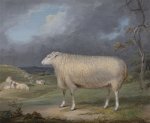The Woollen Mill Problem


By The Other Terrence Oblong
- 1366 reads
I was woken at 6.30 one morning by a hammering on my back door. I quickly dressed and hurried downstairs to find Alun in an exasperated mood.
“It’s Miserable Island, Jed,” Alun said. “They’ve dropped the price of their shoat’s wool fleeces by five mainland pounds.”
Miserable Island is located next to us in the archipelago and is inhabited by Ned and Aaron, who are always copying our latest schemes and activities. They even post details of their adventures to the rival writing website xyztales.com.
Earlier that year, during the geep flu lockdown, Alun had invented the automated geep sheerer, so that our geep could sheer themselves, without the risk of infecting myself or Alun. The geep took to the new technology in unexpected ways, giving themselves a range of fleece styles, geep have a much richer sense of fashion than either myself or Alun, leading them to winning the Guardian’s ‘Cool Geep of the Year’ award.
It is usually stated that geep are unable to breed among themselves, however, this is not the case with Happy Island geep, who simply have a lot more sex than mainland geep. Happy Island geep are also especially hairy (well, woolly) – they need to be sheered every few weeks otherwise they look like long-wooled hippy geep, and that is not a good look.
As a result of the self-sheering mechanism, Alun and I had a lot of free time on our hands. I started to produce geep’s wool sweaters, for the Boatman to sell on the mainland. Alun quickly saw a way to increase output and invented an automatic-knitting machines (slightly different from existing designs in order to avoid patent and copyright issues).
The high quality of the wool and the relative low cost due to automation led to a surge in demand and soon we were unable to meet demand through our usual supply routes.
One morning, I was woken early by a hammering on my back door. I quickly dressed and rushed downstairs, to find Alun, surrounded by a group of children, a sight I hadn’t seen since Alun had singlehandedly solved the mainland’s rat problem (see the Pied Piper Problem).
“What’s going on?” I said.
“It’s mainlanders, Jed,” Alun said. “They’ve come to the island to buy the geep’s wool merchandise directly from us.”
“But they’re all children,” I said.
“The children have come to see your geep,” he said. “I told them we have a geep petting zoo. Just fifty mainland pence.”
“Of course,” I said. “I’ll give you all the grand tour,” I said to the children. “Uncle Alun will collect your 50 pences.”
I gave the children a tour of the geep pens, sheering sheds and general geep hangout areas. Alun even had the idea of selling the children clumps of grass with which to feed the geep.
“I like the geep with the pink Mohican’,” said little Johnny (there is always a little Johnny in every group of children). Indeed, the children loved the geep’s stylish haircuts and posed for selfies and group photographs.
The geep were somewhat bemused by all the attention, but were quickly appeased when Alun negotiated a 50/50 split of the proceeds.
Alun built a woollen mill in the empty house to increase production. He then opened the mill directly to mainland shoppers.
Even with these initiatives, Alun couldn’t keep up with the demand. In order to sell directly to our ever-increasing market, Alun built a geeps’ wool merchant ship, to trade directly with mainlanders.
However, every one of these actions was echoed by Ned and Arron on Miserable Island, who developed their own automated sheering and knitting machines for their island’s shoats. Every we time we started to make a profit, our rivals, they sought to undercut our prices, forcing us to reciprocate, thus eating into our profit margins.
The reduced-price fleeces was the final straw.
“We’ll never match those prices,” I said. “We’re barely breaking even, the geep are working flat out, if they’re not self-sheering they’re being heavily petted by boatloads of children.”
“We’ll have to find a different market, Jed,” Alun said.
“A different market?”
“Yes, only a small number of children are going to make the journey to Happy Island to visit our petting zoo. I’ll build another boat to use as a floating geep petting zoo, so the geep can pet directly to mainland children.”
Alun immediately set about building a floating arc, so that the
However, the next morning I was woken by Alun, in an agitated mood.
“It’s the geep, Jed,” Alun said. “They’re gone.”
“Gone!” I said, surprised, hence the use of the asterisk, which I generally try to avoid.
“Yes Jed, they’ve taken command of the geep arc and have left the island without us.”
“But I thought the geep were happy here. They have everything, grass, water, geep sheds for when in rains, the geep play park for when they want to play. You even built them a special geep-friendly snooker table.”
“Yes Jed, they were happy, but they’ve become fed up with constant demands for their wool, non-stop petting and the noise from the 24-hour woollen mill.”
We later heard that exactly the same thing had happened to Ned and Aaron’s shoat arc, so at least we were able to enjoy a good gloat at their expense.
- Log in to post comments
Comments
At least they can gloat over
At least they can gloat over the shoats - that's something. I wonder if they teamed up with the geep? Thanks for this Terrence
- Log in to post comments
A sign of the times. Years
A sign of the times. Years ago they would have had a branch of Woollies.
Turlough
- Log in to post comments
Just what I needed to read
Just what I needed to read after work on a Wednesday! Made me smile. This is our Pick of the Day. Do share on Facebook and Twitter (yes, I'm still calling it that.) Hope the painting is ok with you, it's by James Ward (late C18th) and definitely in the public domain.
- Log in to post comments
That is a brilliant
That is a brilliant illustration (though its fleece is a bit less flamboyant than the geep)
Congratulations Terrence - very well deserved golden cherries
- Log in to post comments


